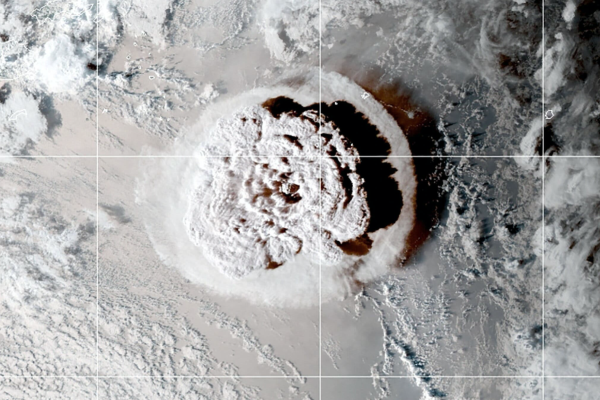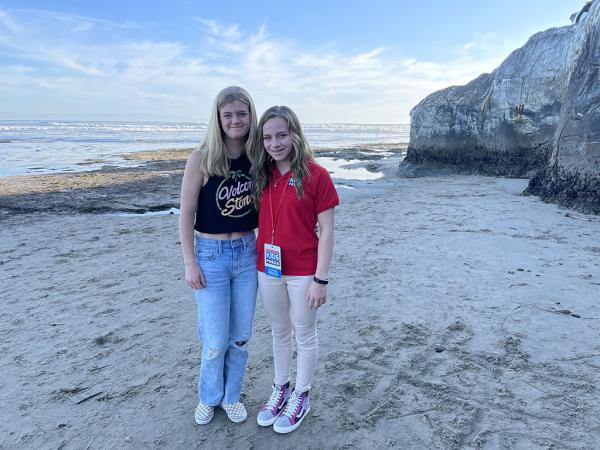KID REPORTERS’ NOTEBOOK
After a Volcanic Eruption, a Tsunami


This satellite image shows an underwater volcanic eruption off the coast of Tonga, which triggered a tsunami.
On January 14, a volcanic eruption occurred about 500 feet underwater near Tonga. The country of Tonga, which is located about 1,100 miles from New Zealand, consists of more than 100 islands in the Pacific Ocean. When the volcano erupted, molten lava came in contact with the ocean water, sending a huge plume of ash into the atmosphere.
“The explosion displaced, or pushed out, a very large volume of seawater that moved out in all directions from the volcano,” said Gary B. Griggs, Distinguished Professor of Earth Sciences at the University of California, Santa Cruz. “This created a tsunami, or series of large waves, spreading out across the Pacific Ocean.”
Traveling across the ocean, the tsunami reached beaches in the California Bay Area the next morning. “Tsunamis travel at speeds of about 450-500 miles per hour,” Griggs explained. “It took about 12 hours for these waves to travel the 5,500 miles from Tonga to California after the eruption.”
Early that morning, the National Oceanic and Atmospheric Administration (NOAA) issued a tsunami advisory to ports and harbors along the West Coast of the United States. Loudspeaker warnings urged people in the immediate area to seek higher ground.
Before the surge hit Santa Cruz beaches, the ocean receded way out beyond normal tide swings. Parts of the ocean floor never seen before were exposed. Then the tsunami surge came in with force. Tide levels rose up to 10 feet. The water surged up the cliffs and covered the sandy beaches.
Soquel Creek, which typically empties into Capitola Beach, was flowing upstream. Volleyball courts, staircases, and lifeguard towers along the Santa Cruz Beach Boardwalk were submerged.
When the momentum of the tsunami hit the harbor, it acted like a funnel. Water rose over the seawalls, flooding restrooms and parking lots, lifting cars into the air. Swells rolled in, pushing boats into the docks. The surge led to more than $6 million in damage.
“The tsunami came at the worst possible time, high tide,” Griggs said. “So it pushed the water in the harbor to an even higher elevation.”

Ella with surfer Holly Hegna on a Santa Cruz beach that was flooded after a volcanic eruption thousands of miles away.
SURFERS AT RISK
The eruption in remote Tonga led to a dramatic moment for two local surf teams in California. On the morning of the tsunami, the Santa Cruz Scholastic Surf League had a a competition scheduled between two area high schools at Pleasure Point. Although warnings had been issued, the contest began at 7:00 a.m.
Holly Hegna, a sophomore from Aptos High School, jumped into the water from the rocks in order to make it out to her heat.
“I had trouble right from the start,” Holly said. “The ocean was totally sucking me out to sea. Luckily, the other girls in my heat were right next to me. We were all kind of clumped together, struggling against the current.”
Holly’s father, Brian Hegna, was there to watch the competition. After seeing that Holly and one of her friends had made it into the water, he headed up the stairs to watch from the cliffs.
“By the time I got to the top of the stairs and turned around, they were both completely out of my view,” Hegna said. “My heart sank since it was at that time I realized they were in the tsunami and getting sucked out to sea.”
Jogging along the cliff, Hegna finally regained sight of Holly and the other surfers in the heat. “They were stuck in the biggest rip current I’ve ever seen,” he said.
Holly was getting pulled farther away from the contest area. She paddled constantly as the waters began to recede.
“The heat was almost over, and I had been paddling for almost 15 minutes straight,” Holly said. “My arms were so tired, they felt like Jello.”
As the tides turned and the surge came in, Holly and the other surfers caught a wave that brought them in. All of the competitors got out of the water safely. This unexpected event canceled the surf contest.
